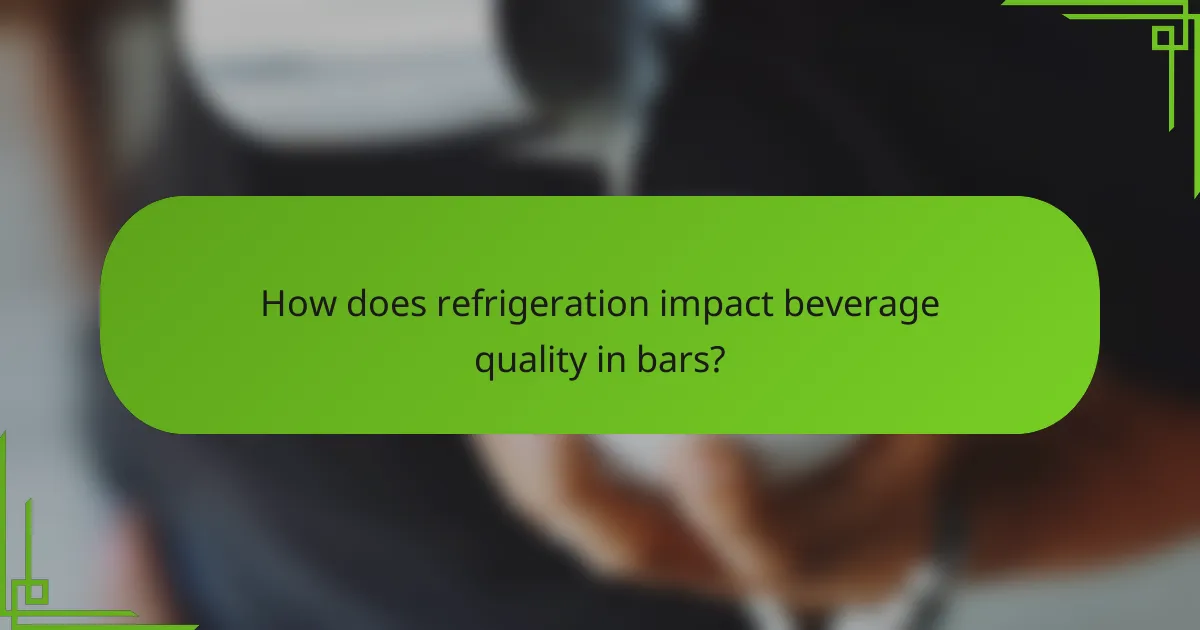In Los Angeles, bars must adhere to stringent refrigeration quality standards that prioritize optimal temperatures and energy efficiency while complying with health and safety regulations. These standards are essential for preserving the quality of beverages and food, ensuring customer satisfaction, and promoting sustainability. Selecting the appropriate refrigeration system tailored to a bar’s specific needs can significantly enhance product quality and reduce operational costs.

What are the refrigeration quality standards for bars in Los Angeles?
In Los Angeles, refrigeration quality standards for bars focus on maintaining optimal temperatures, ensuring energy efficiency, and adhering to health and safety regulations. These standards are crucial for preserving the quality of beverages and food served in bars while promoting sustainability and safety.
Temperature control requirements
Bars in Los Angeles must maintain specific temperature ranges for refrigeration units to ensure the safety and quality of stored items. Typically, refrigeration should be kept between 32°F and 40°F (0°C to 4°C) for perishable goods, while freezers should operate at 0°F (-18°C) or lower. Regular monitoring with calibrated thermometers is essential to maintain these temperatures.
It is advisable to implement a temperature logging system that records data at regular intervals. This helps in identifying any fluctuations that could compromise food safety and allows for timely corrective actions.
Energy efficiency ratings
Energy efficiency is a key consideration for refrigeration systems in bars, as it impacts operational costs and environmental sustainability. Equipment should ideally have an Energy Star rating, indicating it meets strict energy efficiency guidelines set by the U.S. Environmental Protection Agency. This can lead to significant savings on electricity bills over time.
When selecting refrigeration units, look for models that offer features such as variable speed compressors and efficient insulation. These features can enhance energy performance while ensuring reliable temperature control.
Health and safety regulations
Health and safety regulations in Los Angeles require bars to comply with local health codes, which include proper refrigeration practices. This involves regular cleaning and maintenance of refrigeration units to prevent contamination and ensure hygiene. The Los Angeles County Department of Public Health provides guidelines that bars must follow to remain compliant.
Additionally, staff should be trained in safe food handling practices, including the importance of keeping refrigeration units at the correct temperatures and recognizing signs of equipment malfunction. Regular inspections by health officials help ensure adherence to these regulations, which is vital for public safety and business reputation.

How to choose the right refrigeration system for a bar?
Choosing the right refrigeration system for a bar involves assessing your specific needs, including the type of beverages served, space availability, and energy efficiency. A well-selected system ensures optimal storage conditions, enhances product quality, and can reduce operational costs.
Types of refrigeration systems
There are several types of refrigeration systems suitable for bars, including under-counter units, back bar coolers, and walk-in coolers. Under-counter units are compact and ideal for limited spaces, while back bar coolers provide easy access to frequently used beverages. Walk-in coolers offer larger storage capacities for high-volume establishments.
Each system has its advantages; for instance, under-counter units are energy-efficient, while walk-in coolers allow for bulk storage. Consider the volume of products you need to store when selecting the type.
Size and capacity considerations
When choosing a refrigeration system, size and capacity are critical factors. Assess your bar’s layout and the expected volume of beverages to determine the appropriate size. For example, a small bar may only require a few under-counter units, while a larger venue may need multiple walk-in coolers.
As a general rule, aim for a refrigeration capacity that can handle at least 20-30% more than your peak inventory needs to ensure efficiency and reduce strain on the system.
Brand recommendations for bars
Several reputable brands specialize in refrigeration systems for bars, including True, Beverage-Air, and Turbo Air. True is known for its durability and energy efficiency, making it a popular choice among bar owners. Beverage-Air offers a range of customizable options, while Turbo Air is recognized for its innovative technology and reliability.
When selecting a brand, consider factors such as warranty, customer service, and energy efficiency ratings. Reading reviews and seeking recommendations from other bar owners can also provide valuable insights into the best options for your establishment.

What are the common refrigeration issues in bars?
Common refrigeration issues in bars include temperature fluctuations, energy inefficiency, and maintenance challenges. Addressing these problems is crucial for maintaining product quality and ensuring customer satisfaction.
Temperature fluctuations
Temperature fluctuations can lead to spoilage of perishable items and affect the quality of beverages. Ideally, refrigeration units should maintain a consistent temperature between 0°C and 4°C for optimal storage. Frequent opening of doors or malfunctioning equipment can cause these fluctuations, so monitoring systems are essential.
To mitigate this issue, consider investing in digital temperature monitoring devices that alert staff to changes. Regularly check door seals and ensure that refrigeration units are not overloaded, as this can impede airflow and cause uneven cooling.
Energy inefficiency
Energy inefficiency in refrigeration can significantly increase operational costs for bars. Units that are not properly maintained or are outdated may consume more energy, leading to higher electricity bills. A well-functioning refrigerator should ideally operate at an energy efficiency ratio (EER) that meets or exceeds local standards.
To improve energy efficiency, regularly clean condenser coils and ensure that the unit is placed in a cool, shaded area. Consider upgrading to energy-efficient models that are ENERGY STAR certified, which can save up to 30% on energy costs compared to standard units.
Maintenance challenges
Maintenance challenges can arise from neglecting regular servicing of refrigeration equipment. Common issues include refrigerant leaks, compressor failures, and dirty filters, which can lead to costly repairs and downtime. Establishing a routine maintenance schedule is vital for preventing these problems.
Bars should conduct monthly inspections and engage professional technicians for annual servicing. Keeping a log of maintenance activities can help identify recurring issues and ensure compliance with local health regulations. Regular training for staff on proper usage and care can also minimize wear and tear on refrigeration units.

What are the best practices for maintaining bar refrigeration?
Maintaining bar refrigeration involves regular upkeep, monitoring, and professional servicing to ensure optimal performance. Following best practices helps preserve the quality of beverages and prevents costly equipment failures.
Regular cleaning schedules
Establishing a regular cleaning schedule is essential for maintaining bar refrigeration systems. Clean the condenser coils and evaporator units at least once a month to prevent dust buildup, which can hinder efficiency.
Additionally, ensure that the interior of the refrigeration units is sanitized weekly. This not only keeps the equipment functioning well but also helps maintain the quality of the drinks served.
Monitoring temperature logs
Consistently monitoring temperature logs is crucial for ensuring that refrigeration units operate within the ideal range, typically between 0°C to 4°C (32°F to 39°F) for most beverages. Use digital thermometers with data logging capabilities for accurate tracking.
Regularly review these logs to identify any fluctuations or trends that may indicate potential issues. Addressing temperature deviations promptly can prevent spoilage and maintain product quality.
Professional servicing recommendations
Engaging a professional technician for regular servicing is vital for the longevity of refrigeration equipment. Schedule maintenance at least twice a year to check for refrigerant levels, compressor functionality, and overall system performance.
During these service visits, technicians can also provide insights on any necessary repairs or upgrades, ensuring compliance with local regulations and standards. This proactive approach minimizes downtime and extends the lifespan of the equipment.

What permits are required for refrigeration installation in bars?
Bars need several permits for refrigeration installation to ensure compliance with local laws and safety standards. Key permits typically include those from health departments, adherence to building codes, and consideration of environmental regulations.
Local health department permits
Local health departments require permits to ensure that refrigeration systems meet health and safety standards. These permits often involve inspections to verify that the equipment is suitable for food storage and that it operates efficiently to prevent spoilage.
To obtain these permits, bars must submit plans detailing their refrigeration systems, including specifications and installation locations. It’s advisable to check with the local health authority for specific requirements, as they can vary significantly by region.
Building code compliance
Building codes dictate the structural and safety requirements for refrigeration installations in bars. Compliance ensures that the systems are installed safely and do not pose hazards such as electrical issues or improper ventilation.
Bars should consult local building codes before installation to understand requirements related to electrical connections, structural support, and accessibility. Engaging a licensed contractor familiar with local codes can help streamline this process.
Environmental regulations
Environmental regulations govern the use of refrigerants and energy efficiency standards for refrigeration systems. Bars must ensure that their refrigeration units comply with regulations aimed at reducing greenhouse gas emissions and promoting energy conservation.
It’s essential to choose refrigerants that are compliant with local environmental laws, as some substances may be banned or restricted. Additionally, consider energy-efficient models that can help reduce operational costs and environmental impact, aligning with sustainability goals.

How does refrigeration impact beverage quality in bars?
Refrigeration plays a crucial role in maintaining the quality of beverages served in bars. Proper cooling preserves flavors, aromas, and overall freshness, ensuring that customers enjoy their drinks as intended.
Temperature Control
Temperature control is vital for beverage quality, as different drinks require specific cooling levels. For instance, lagers and ales are best served between 4°C and 7°C, while red wines should be slightly warmer, around 15°C to 18°C. Maintaining these temperatures helps to enhance the taste and aroma of the beverages.
Bars should regularly monitor their refrigeration units to ensure they are operating within the ideal temperature ranges. Using thermometers and temperature logs can help identify any fluctuations that may affect beverage quality.
Humidity Levels
Humidity levels in refrigeration units can significantly impact beverage quality, especially for wines and certain spirits. Ideally, humidity should be maintained between 50% and 70% to prevent corks from drying out and to preserve the integrity of the beverages.
Bars can use hygrometers to monitor humidity levels and adjust their refrigeration settings accordingly. If humidity is too low, consider using a humidifier or placing a shallow dish of water inside the unit to help maintain optimal conditions.
Storage Practices
Proper storage practices are essential for maximizing beverage quality in bars. Beverages should be stored upright to prevent leakage and contamination, especially for bottled drinks. Additionally, avoid overcrowding refrigeration units to ensure proper air circulation.
Organizing beverages by type and usage frequency can also improve efficiency and help staff quickly access the drinks they need. Regularly rotating stock ensures that older items are used first, minimizing waste and maintaining freshness.
Regular Maintenance
Regular maintenance of refrigeration units is crucial for optimal performance and beverage quality. This includes cleaning condenser coils, checking door seals, and ensuring that the temperature settings are accurate. Neglecting maintenance can lead to inefficient cooling and potential spoilage of beverages.
Establishing a routine maintenance schedule can help bars avoid costly repairs and ensure that their refrigeration systems operate effectively. Consider hiring a professional technician for annual inspections to keep equipment in top condition.


